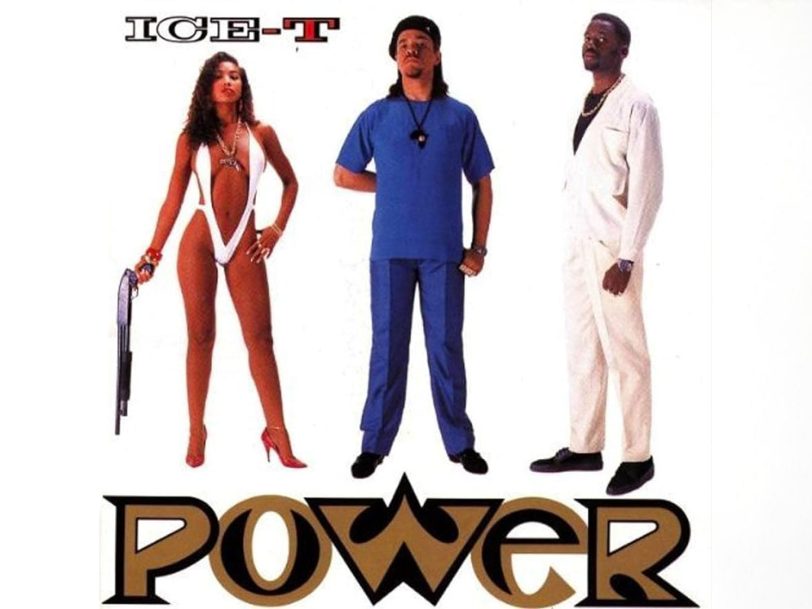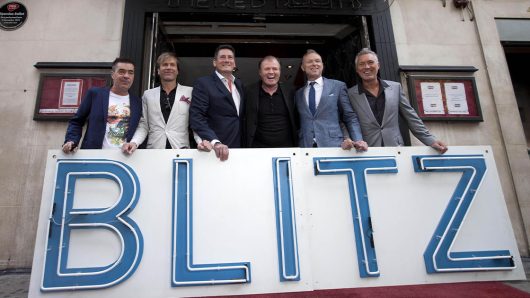In case anybody who hasn’t heard it is wondering what Ice-T’s second album, Power, is about, the answer is on the front cover: guns and girls. There he is in the centre, between DJ Evil E and Darlene Ortiz, his then girlfriend, who is wearing a swimsuit that would not keep a lot of water out. Ortiz is also holding a firearm. Turn the sleeve over, and we see she was not the only one to come strapped. These people are here to defend themselves or commit a crime. Maybe both. It ain’t exactly subtle. Which makes it kind of curious that Ice-T’s lyrics do not shy away from the mishaps, humour, chaos and plain stupid tragedy of the gangsta life: there’s a lot more to Power than mere glorification of the OG lifestyle.
The backstory: Cold ambition made gangsta a phenomenon
Original gangsta? Ice-T claimed that title with a later album, and his case was a reasonable one, so far as hip-hop’s history is concerned. If East Coast rappers Just Ice and Schoolly D were spitting bars about gang business before Ice-T (aka Tracy Marrow) released his genre-defining single, 6 ’N The Mornin’, he was not far behind, and made the style his own.
For some time, Ice-T was the gangsta rapper; even his West Coast rivals N.W.A were trying to catch up. His skills were sufficient enough to attract a deal with Sire Records after half a dozen singles for indie labels. Sire had a reputation for making icons of artists who sought to break the mould, such as Madonna and Ramones. Why shouldn’t the company do the same for this tough-talking Californian? He was certainly full of ambition, perhaps because he was a touch older than most rising rappers, so he needed to get a shake on. Ice-T’s work practically demanded to be heard.
His debut album, Rhyme Pays (issued in a far more modest sleeve than its follow-up), made the Top 100 in 1987, a time when the US album charts were not the natural home for hip-hop, least of all its West Coast branch. Ice-T was on the verge of something big, but his second album needed to be exceptional to make him the star he really could be. With this in mind, he and his producer, New York City-based hip-hop pioneer Afrika Islam, set about creating Power as a no-holds-barred opus de gangsta funk. If anyone closed the doors to Ice-T, he was going to blast his way in.
Generating ‘Power’: making a monster
Afrika Islam was a crucial figure in Ice-T’s success. Having been a protégé of hip-hop pioneer Afrika Bambaataa and a radio DJ and promoter in his own right, there was little he didn’t know about hip-hop. His knowledge of constructing beats was muscle memory to him: though he had the same number of hands and ears as most of humanity, he used four decks when he was delivering his remarkable turntablism.
He was quick to adopt the E-mu SP-1200 sampler, technology which was rapidly transforming the way hip-hop was produced in the late-80s, and his sound also shifted from the Roland TR-808 drum machine, which had hitherto ruled rap, utilising instead its successor, the 909, which would soon be heavily associated with house music. While producing Power, Islam also adopted the TB-303 bass synth, which gave some cuts a radical electronic flavour that landed somewhere between the nascent acid house sound and the oncoming whining synth undertows of early-90s G-funk.
This future funk made Ice-T sound like he was tuned into an alien cosmos while still spitting the verbiage of 1988’s bloodied streets. Of course, there were choice vintage breakbeats, too; funk has roots as well as a future. The chosen venue for cutting this monster album was Syndicate Studios West, the home of Ice-T’s sparring partner, DJ Evil E. It wasn’t just that Ice-T felt relaxed and able to give his best work at the crib of an ally; the studio had car speakers rigged up in the mixing suite, so they could hear how the album might sound pouring out of a jeep.
Nothing was left to chance; they had all the time they wanted to lay the tracks at Syndicate Studios West. But it turned out they didn’t need to stretch anyone’s schedule: Ice-T was inspired, and in full flow throughout. For a touch of big-label shine, they mixed the album at Entourage Studios, in North Hollywood, with Mark Wolfson at the desk. It took no more than a few weeks to reveal Ice-T’s true Power.
The songs: Presenting the gang life, rather than living it
You can forget the widely held notion that De La Soul invented the hip-hop skit: it doesn’t hold water. Power was released on 13 September 1988 and, after a brief rhymed statement of intent from Ice-T himself, it kicks off with a skit in which one homeboy shoots another simply to get hold of the very album you are listening to.
Then Power’s title track kicks in. The layered samples of James Brown’s I Don’t Want Nobody To Give Me Nothing (Open Up The Door, I’ll Get It Myself) and Jimmy Castor’s It’s Just Begun; the relentless, curiously flat-sounding robotic hi-hat; the way the tune flips direction: this could almost be a Bomb Squad production. But Ice-T’s lyrics predate Public Enemy’s Fight The Power, and his assertions aren’t political with a capital “P”. He details the growing power he holds as a microphone prince, his right to be where he is, his long apprenticeship, and the power held by the rich over the poor; the power balance in relationships and how, once you’ve got it, the benefits power brings.
This killer jam is followed by Drama, a tale of gang life that reveals how chancy fun can end in death. Contrary to expectation, Ice-T’s recitation is anything but dramatic here: he’s stating the facts over Afrika Islam’s bubbling 303, which gives the song an otherworldly mystery. Why does he sound so dry? Because he’s saying “That’s how we’re living”, even if it’s a drama for everybody else.
Ice-T is now presenting the gang life, rather than living it (assuming this ex-serviceman really was). But he still had a posse, and you can hear about that on The Syndicate, which launched Ice-T’s beef with LL Cool J, who also gets an unfavourable mention on the Curtis Mayfield-sampling I’m Your Pusher/Pusherman, despite other rival acts getting considerable props, Public Enemy, Biz Markie and Boogie Down Productions among them. The latter song was Power’s best-known cut at the time, released as a single, and draws parallels between dealing addictive music and drugs, though the insight it offers probably went over the head of some listeners. Ice-T hands the mic to Pimpin’ Rex, who sings a few bars in a Mayfield-like role; he’s one of several guests on the album and, according to the star of the show, a genuine hustler. Power’s other single was the slinky, low-ridin’ High Rollers, a more subtle groover.
Another cut that made an impact was anything but subtle, despite using an acronym instead of spelling out its adults-only title: Girls L.G.B.N.A.F. The youthful icon of East Coast rap again had an inadvertent role in the track’s creation: Ice-T wrote it as a jokey and filthy response to LL Cool J’s romantic hit I Need Love, which had drawn a divided response in hip-hop. The beats are oddly retro here, as they are in The Syndicate. Maybe it was Ice-T wanting to make it clear he’d been doing this since the old school was the new school, or perhaps it was just a sign of hip-hop styles shifting in 1988. Either way, both tunes are bombs that sit comfortably alongside the album’s more complex constructions. They also show off the rapper’s rhyme style perfectly.
But Ice-T wasn’t a one-spit pony: he had other ways to deliver his lyrics. The remarkable Soul On Ice is a brilliant tribute to his original inspiration, Iceberg Slim, and its title also offers homage to another pioneering Black literary figure, Eldridge Cleaver. Using an abstract jazzy funk backing track, Ice-T tells of the hustler’s life in the manner of Lightnin’ Rod’s Hustler’s Convention. Nobody could accuse this new star of an ignorance of hip-hop’s culture: he knew the music’s roots. Power closes it’s account here, save a short sequel to the album’s starting skit. Even this refuses to pull its punches: the homeboy who is apparently bleeding out on the floor could be saved, but the shooter is still too absorbed in the album to help.
The reception: Critics loved ‘Power’, and they were right to
Power made No.35 in the Billboard chart and went gold. But it didn’t entirely bust Ice-T out of the ghetto as much as he presumably would have liked. At the time, Ice-T was considered to have an element of risk about him; always quotable, he’d say shit few others would dare to, both on the mic and in the media. It may also have worked against him that another of Power’s key cuts, Radio Suckers, sprayed DJs and producers with genuine grievances: for example, he demanded to know why they didn’t they just bleep him the way they bleeped other rappers, if they considered his lyrics unsuitable for the airwaves.
But maybe Ice-T was just too raw for mass marketing and superstardom at this point. That would change soon enough. Power became a considerable foundation stone in his career, and maybe his steady rise was all to the good: Ice-T remains one of the few figures from his era whose name prompts instant recognition. For the most part, the critics loved Power, and they were right to.
The legacy: It’s still hard-hitting. It still rocks your soul
As for its legacy, along with N.W.A’s Straight Outta Compton, Power was one of two rap albums that were critical in establishing the gangsta style as dominant in rap, to the extent where so many other styles are still seen as “alternative”. It also made Ice-T a major media figure, seemingly always having a mic thrust under his nose to speak his mind.
Soon Hollywood would come calling for him, too, and Ice-T’s ventures into heavy metal, with Body Count, made it clear he could communicate in different musical media. As for how Power sounds today, it’s still hard-hitting. The technology of music-making may have moved on, and the production values are now very different, but the record rocks your soul. It’s still got the Power.
Buy ‘Power’ on “Ice Cold Gold” vinyl.
More Like This
Why Cher’s Christmas Album Is Already A Modern Classic
Taking even its creator by surprise, Cher’s Christmas album is as traditional as it is unexpected, bearing the pop icon’s stamp throughout.
How Spandau Ballet’s Live Debut Launched The New Romantic Movement
With Christmas 1979 approaching, Spandau Ballet made their debut live show, igniting a pop revolution soon billed the New Romantic movement.
Be the first to know
Stay up-to-date with the latest music news, new releases, special offers and other discounts!




